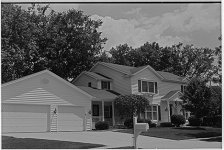Ronald M
Veteran
I ordered and received a 100 feet of the new version of Plus X, well it is a few years old. It was my standard film since 1965 but I drifted away when Kodak said they wanted out of the film business. They have since changed their business model.
Now that I nailed the developing time for the new emulsion on the third try, the prints are simply stunning, fine grain,sharp, beautiful tonal range. One test roll was with a 111C and like new condition Summitar, the other was an my M6 and new version 50 2.8.
Home made D76 1:1 ( reg formula) 68 for 7.5 min at 68-no rinse or stop-TF4 fix 3 minutes- Ilford wash sequence. Nothing special. Agitation 5 inversions every 30 sec. Nikor tank and drop the loaded reel in at 7.5 and start pour out at 15 sec to end. The Kodak times were way long, 8.5 min. Printing was on my Leica V35 with 2.5 grade filtration. A Focomat 1c should be at #2 or no filter.
Here is the problem. It does not scan well. Blown highlights, big grain. I can get it to look better if I adjust the curve so the last 20% goes up at an 75/80 deg angle and the rest is straight. Then I get nice separation in the sky and puffy white clouds. I can`t seem to find a point where it scans with detail everywhere like the Tri x or Delta 100 do.
I am using a Minolta 5400 scanner in black and white neg mode, Minolta software. Any suggestions?
The grain in even tone grey on prints is virtually invisable on 8x10 prints, but looks terrible in the scan at 1350 ppi or 5400 ppi.
If you print in a darkroom, I suggest you try a roll or two. This is the nicest film I ever used.
Now that I nailed the developing time for the new emulsion on the third try, the prints are simply stunning, fine grain,sharp, beautiful tonal range. One test roll was with a 111C and like new condition Summitar, the other was an my M6 and new version 50 2.8.
Home made D76 1:1 ( reg formula) 68 for 7.5 min at 68-no rinse or stop-TF4 fix 3 minutes- Ilford wash sequence. Nothing special. Agitation 5 inversions every 30 sec. Nikor tank and drop the loaded reel in at 7.5 and start pour out at 15 sec to end. The Kodak times were way long, 8.5 min. Printing was on my Leica V35 with 2.5 grade filtration. A Focomat 1c should be at #2 or no filter.
Here is the problem. It does not scan well. Blown highlights, big grain. I can get it to look better if I adjust the curve so the last 20% goes up at an 75/80 deg angle and the rest is straight. Then I get nice separation in the sky and puffy white clouds. I can`t seem to find a point where it scans with detail everywhere like the Tri x or Delta 100 do.
I am using a Minolta 5400 scanner in black and white neg mode, Minolta software. Any suggestions?
The grain in even tone grey on prints is virtually invisable on 8x10 prints, but looks terrible in the scan at 1350 ppi or 5400 ppi.
If you print in a darkroom, I suggest you try a roll or two. This is the nicest film I ever used.


